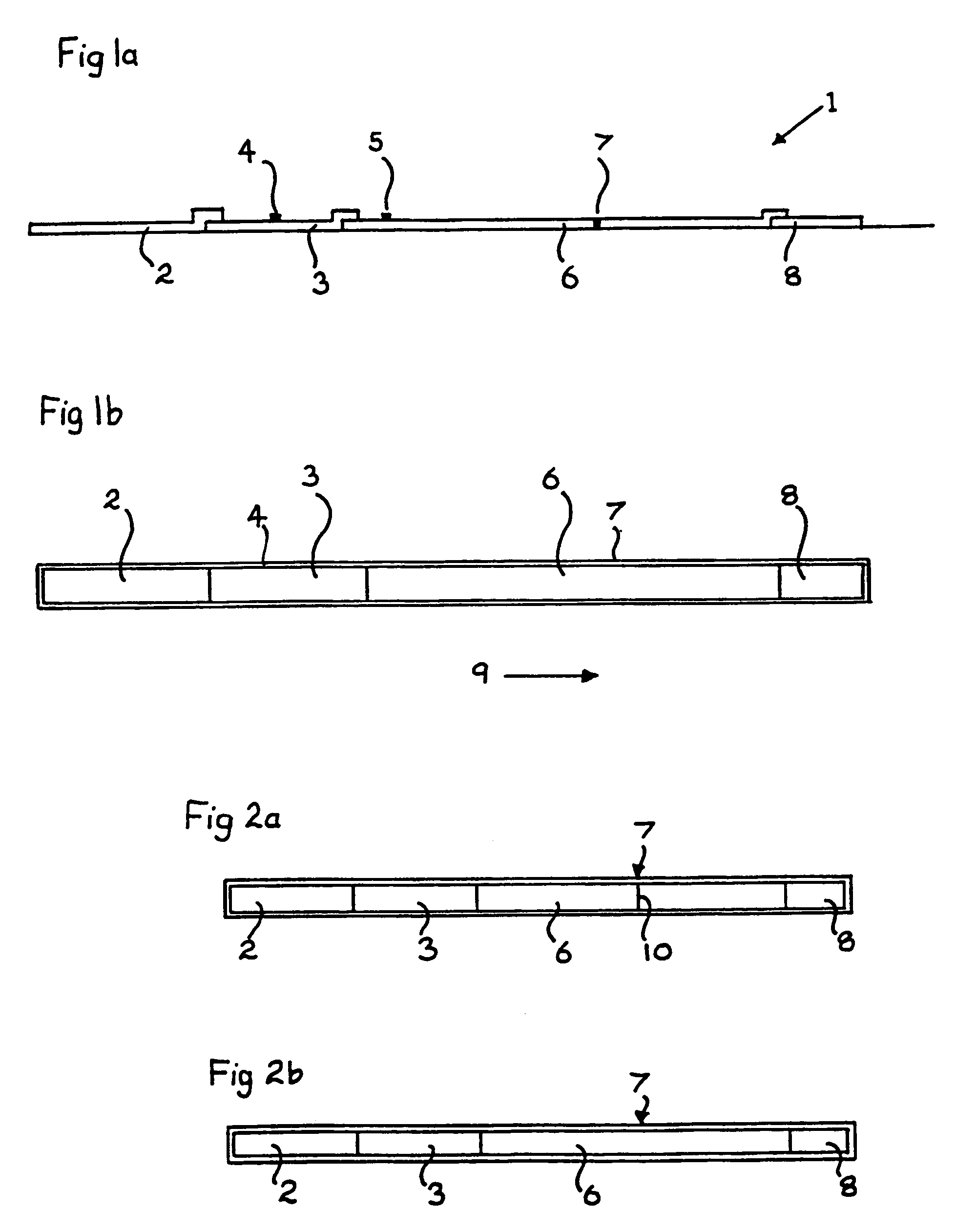Assays for autoantibodies
a technology of autoantibodies and autoantibody, which is applied in the field of autoantibodies assays, can solve the problems of affecting the inability to carry out current assays in specially equipped laboratories, and the distortion of the feedback system, so as to achieve the effect of improving the accuracy of autoantibodies and reducing the risk of autoantibodies
- Summary
- Abstract
- Description
- Claims
- Application Information
AI Technical Summary
Benefits of technology
Problems solved by technology
Method used
Image
Examples
example 1
[0154]The following tables give the results obtained using a TPO screening kit as shown in FIGS. 1a and 1b and a Tg screening kit as shown in FIG. 4.
[0155]
TABLE 1Patient sample results - TPOAbTPOAb rapid assayTPOAbconcentration byQualitativeradioactive assayresult by rapidPatient sample(U / ml)assay+TPOAb1165.6(+)+219.0(+)+314.6(+)+456.6(+)+550.1(+)+6108.7(+)+7171.4(+)+890.7(+)+−TPOAb90.2(−)−100.1(−)−110.2(−)−120.2(−)−130.3(−)−140.3(−)−
[0156]
TABLE 2Patient sample results - TgAbTgAb rapid assayTgAbconcentration byQualitativeradioactive assayresult by rapidPatient sample(U / ml)assay+TgAb152.4 (+)+245.3 (+)+−TgAb3Neg−4Neg−
example 2
[0157]This Example describes screening for autoantibodies to Tg using a kit as illustrated in FIGS. 7 and 8.
[0158]90 μl of plasma (or sera) or 30 μl of whole blood plus 60 μl of a diluent buffer (150 mM NaCl, 20 mM Tris pH7.6) were used. Results were obtained after 10 minutes. Prior art reference radioactive method was based on that of Beever et al Clinical Chemistry 35 (1989) 1949–954.
[0159]
TABLE 3(a) Results obtained in whole blood or plasma obtainedfrom 30 healthy blood donors.whole blood(Reference methodplasmacannot be used with(n = 30)whole blood)Tg autoantibody positive by 3 / 30—reference radioactive testTg autoantibody positive by 3 / 30 1 / 30a method according to thepresent invention employinga kit as illustrated inFIGS. 7 and 8Tg autoantibody negative by27 / 30—reference radioactive testTg autoantibody negative27 / 3029 / 30by a method according tothe present inventionemploying a kit asillustrated in FIGS. 7and 8
[0160]
TABLE 4(b) Results obtained with sera from patients withsystemic l...
example 3
[0162]The Example describes screening for autoantibodies to TPO using a kit as illustrated in FIGS. 9 and 10. 90μl of plasma (or sera) or 30 μl of whole blood plus 60 μl of a diluent buffer (150 mM Nacl; 20 mM Tris pH 7.6) were used. Results were obtained after 10 minutes. Prior art reference radioactive method was based on that of Beever et al Clinical Chemistry 35 (1989) 1949–1954.
[0163]
TABLE 5(a) Results obtained in whole blood or plasma obtainedfrom 30 healthy blood donorswhole blood(reference methodcannot be used withplasmawhole blood)TPO autoantibody positive 3 / 30—by reference radioactivetestTPO autoantibody positive 3 / 30 3 / 30by a method according tothe present inventionemploying a kit asillustrated in FIGS. 9and 10TPO autoantibody negative27 / 30—by reference radioactivetestTPO autoantibody negative27 / 3027 / 30by a method according tothe present inventionemploying a kit asillustrated in FIGS. 9and 10
[0164]
TABLE 6(b) Results obtained in sera from patients with suspectedautoimmune ...
PUM
| Property | Measurement | Unit |
|---|---|---|
| pH | aaaaa | aaaaa |
| colorimetric change | aaaaa | aaaaa |
| Tg | aaaaa | aaaaa |
Abstract
Description
Claims
Application Information
 Login to View More
Login to View More - R&D
- Intellectual Property
- Life Sciences
- Materials
- Tech Scout
- Unparalleled Data Quality
- Higher Quality Content
- 60% Fewer Hallucinations
Browse by: Latest US Patents, China's latest patents, Technical Efficacy Thesaurus, Application Domain, Technology Topic, Popular Technical Reports.
© 2025 PatSnap. All rights reserved.Legal|Privacy policy|Modern Slavery Act Transparency Statement|Sitemap|About US| Contact US: help@patsnap.com



